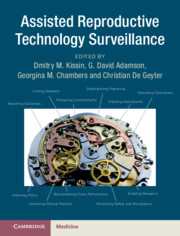Book contents
- Frontmatter
- Contents
- Foreword
- List of Contributors
- Section 1 Introduction to ART Surveillance
- Section 2 General Principles of ART Surveillance
- Section 3 Using ART Surveillance Data
- 5 Reporting ART Success Rates
- 6 Using ART Surveillance Data in Clinical Research
- 7 Monitoring ART Safety and Biovigilance
- 8 Quality Assurance of ART Practice: Using Data to Improve Clinical Care
- 9 Monitoring Long-Term Outcomes of ART: Linking ART Surveillance Data with Other Datasets
- 10 Use of ART Surveillance by People Experiencing Infertility
- Section 4 Global Variations in ART Surveillance
- Section 5 Surveillance of Non-ART Fertility Treatments
- Appendix A ART Surveillance System Variables and Definitions
- Appendix B International Glossary on Infertility and Fertility Care
- Appendix C ICMART Data Collection Form
- Index
- Plates
6 - Using ART Surveillance Data in Clinical Research
from Section 3 - Using ART Surveillance Data
Published online by Cambridge University Press: 14 June 2019
- Frontmatter
- Contents
- Foreword
- List of Contributors
- Section 1 Introduction to ART Surveillance
- Section 2 General Principles of ART Surveillance
- Section 3 Using ART Surveillance Data
- 5 Reporting ART Success Rates
- 6 Using ART Surveillance Data in Clinical Research
- 7 Monitoring ART Safety and Biovigilance
- 8 Quality Assurance of ART Practice: Using Data to Improve Clinical Care
- 9 Monitoring Long-Term Outcomes of ART: Linking ART Surveillance Data with Other Datasets
- 10 Use of ART Surveillance by People Experiencing Infertility
- Section 4 Global Variations in ART Surveillance
- Section 5 Surveillance of Non-ART Fertility Treatments
- Appendix A ART Surveillance System Variables and Definitions
- Appendix B International Glossary on Infertility and Fertility Care
- Appendix C ICMART Data Collection Form
- Index
- Plates
Summary
Assisted reproductive technology (ART) surveillance data are important for assessing ART effectiveness and safety. Cycle-level and patient-level data allow the most detailed analysis. In using these data for research, it is important to recognize the strengths and limitations of surveillance data. The large sample size can facilitate precise estimation of the relationships between patient or treatment factors and outcomes, as well as permit detection of rare outcomes and trends over time. However, these databases may have limited detail compared with those designed specifically for research. Surveillance data allow the researcher to assess associations, but cannot prove causation. Appropriate strategies should be employed to address and communicate the limitations whenever possible. ART surveillance data should be available to interested and responsible researchers. Continued efforts to expand ART surveillance to additional countries will benefit the diverse population of women and men who are attempting to build their families using ART.
- Type
- Chapter
- Information
- Assisted Reproductive Technology Surveillance , pp. 47 - 55Publisher: Cambridge University PressPrint publication year: 2019
- 1
- Cited by

